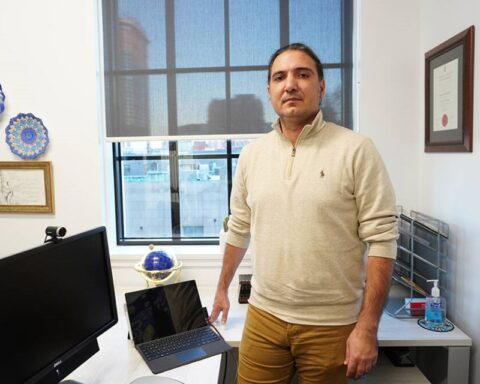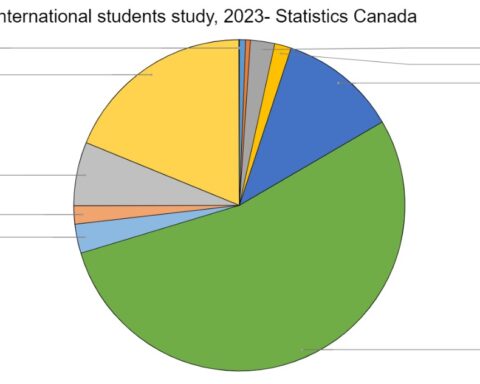Sitting cross-legged on a thin UNHCR mat covering a concrete floor and nursing her 14-month-old, Yasmeen Al-Alow was glad to be out of the jail that is Village 5 — Azraq’s notorious camp-within-the-camp.
Surrounded by barbed wire, Village 5 and Village 2 are where new Syrian refugees were taken before Jordan sealed its borders. Those inside the villages haven’t been allowed outside the wire for months. The Jordanian government fears the new arrivals pose a security threat to the other refugees in the camp. Containing new refugees in the prison-like camps is one way to decrease the chance of ISIS infiltration, authorities say.
Those living in Village 5 and Village 2 are virtual prisoners; unlike Syrian refugees who live in Azraq’s other villages, they are not allowed to walk through the streets, to the supermarket, or anywhere at all.
The Azraq refugee camp, located in a remote, sweltering desert landscape southeast of the capital Amman, is home to nearly 40,000 Syrian refugees who fled the civil war. Half of Azraq’s residents are children.
Most of the Syrians living in Villages 5 and 2 arrived from a desert region surrounded by sandbanks along the Jordanian border. The United Nations estimates that more than 85,000 people are stranded in Ruqban — a camp near the point where Jordan, Syria and Iraq meet — and Hadalat camp, 80 km to the west, where Al-Alow and her family were stranded for months.
The Azraq refugee camp, located in a remote, sweltering desert landscape southeast of the capital Amman, is home to nearly 40,000 Syrian refugees who fled the civil war. Half of Azraq’s residents are children.
iPolitics asked to visit Villages 5 and 2. A government official at the camp said it’s forbidden, citing security reasons. Photos were not permitted, either.
Since November, the Canadian government has welcomed nearly 30,000 Syrian refugees. King Abdullah of Jordan told the BBC in February that his country is at the “boiling point” because of an influx of hundreds of thousands of Syrian refugees. The king said the international community has to offer more help if it wants Jordan to continue taking refugees.
The Jordanian government compromised, however, and set up Village 5 in March. It was a move intended to help international aid agencies trying to expedite the admission of thousands of refugees, like Al-Alow, who were stuck waiting at the border.
Al-Alow, 21, and her husband Muhammed, 26, had been living in their new caravan in Village Six for just over a week. Two jugs of water and a small kettle sat atop the small table at the front of the caravan that serves as a kitchen.
Al-Alow said she and her family are refugees by accident. They left their home in Syria a few months ago with the intention of visiting family in Jordan — but when they arrived at the Syrian border, they had no choice but to live in the berm while they waited to get into Jordan. That wait took four months; by then, the smugglers who drove them to the Syrian border could not take them back home.
“My family came to visit from Kuwait and they were on the other side of the barbed wire,” Al-Alow said via a translator. That visit lasted five minutes.
“We didn’t talk. We just cried.”
Kuwait has also sealed its borders, blocking Syrians from joining family members there.
Najwa Al-Shaikh, 32, and her four children arrived from Syria a few months ago; her family also lived in Village 5. Al-Shaikh’s mother arrived beforehand so their caravan is quite homey. Her mother has set up a little convenience store where children come to buy candy.
Despite the 35-degree heat, Al-Shaikh offered me hot tea and sugar on a silver tray, a display of Syrian hospitality found in every caravan I visited.
Al-Shaikh said she and her young children waited in the desert for months with little food or water in harsh conditions before they were granted permission to enter Jordan.
Her husband was arrested by Bashar al-Assad’s regime, she said. Sometimes, regime authorities tell her that her husband is still alive — other times they tell her he’s been killed.
She gestured toward her 11-year-old daughter Ala, who pulled up her pant cuff to reveal a thin leg covered with scars.
Despite the 35-degree heat, Al-Shaikh offered me hot tea and sugar on a silver tray, a display of Syrian hospitality found in every caravan I visited.
“One of my daughters was killed by the regime, and Ala was injured by the rockets,” she said. All Ala remembers is playing in the playground that day.
The situation in Azraq is “very bad,” the young woman said. Her mother shook her head and suggested that in a month or two, her daughter will adjust.
Aecha Mohammed Shaban, 29, and her four children are thankful for the safety the camp offers.
“In the beginning it was very difficult to live here, how can we live here?” said Shaban, sitting on a long cushion which doubles as a bed for her and her children at night.
Suddenly, the sound of gunshots coming from a nearby military base shattered the desert silence. The children — who had been smiling by their mother’s side — covered their ears and began to cry.
iPolitics’ Janice Dickson visited Jordan from July 9 – July 25th. Dickson spent long days in Jordan’s refugee camps talking to Syrian refugees about the challenges in the camps and their gruelling journey across the desert to get there.
Republished in partnership with iPolitics.ca




